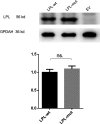Identification and functional characterization of a novel heterozygous missense variant in the LPL associated with recurrent hypertriglyceridemia-induced acute pancreatitis in pregnancy
- PMID: 31962008
- PMCID: PMC7057096
- DOI: 10.1002/mgg3.1048
Identification and functional characterization of a novel heterozygous missense variant in the LPL associated with recurrent hypertriglyceridemia-induced acute pancreatitis in pregnancy
Abstract
Background: Acute pancreatitis in pregnancy (APIP) is a life-threatening disease for both mother and fetus. To date, only three patients with recurrent hypertriglyceridemia-induced APIP (HTG-APIP) have been reported to carry rare variants in the lipoprotein lipase (LPL) gene, which encodes the key enzyme responsible for triglyceride (TG) metabolism. Coincidently, all three patients harbored LPL variants on both alleles and presented with complete or severe LPL deficiency.
Methods: The entire coding regions and splice junctions of LPL and four other TG metabolism genes (APOC2, APOA5, GPIHBP1, and LMF1) were analyzed by Sanger sequencing in a Han Chinese patient who had experienced two episodes of HTG-APIP. The impact of a novel LPL missense variant on LPL protein expression and activity was analyzed by transient expression in HEK293T cells.
Results: A novel heterozygous LPL missense variant, p.His210Leu (c.629A > T), was identified in our patient. This variant did not affect protein synthesis but significantly impaired LPL secretion and completely abolished the enzymatic activity of the mutant protein.
Conclusion: This report describes the first identification and functional characterization of a heterozygous variant in the LPL that predisposed to recurrent HTG-APIP. Our findings confirm a major genetic contribution to the etiology of individual predisposition to HTG-APIP.
Keywords: HTG-APIP; lipoprotein lipase (LPL) gene; missense variant; recurrent acute pancreatitis in pregnancy.
© 2019 The Authors. Molecular Genetics & Genomic Medicine published by Wiley Periodicals, Inc.
Conflict of interest statement
The authors declare no conflict of interest.
Figures





Similar articles
-
The East Asian-specific LPL p.Ala288Thr (c.862G > A) missense variant exerts a mild effect on protein function.Lipids Health Dis. 2023 Aug 7;22(1):119. doi: 10.1186/s12944-023-01875-3. Lipids Health Dis. 2023. PMID: 37550668 Free PMC article.
-
Identification of a novel LPL nonsense variant and further insights into the complex etiology and expression of hypertriglyceridemia-induced acute pancreatitis.Lipids Health Dis. 2020 Apr 7;19(1):63. doi: 10.1186/s12944-020-01249-z. Lipids Health Dis. 2020. PMID: 32264896 Free PMC article.
-
Significant but partial lipoprotein lipase functional loss caused by a novel occurrence of rare LPL biallelic variants.Lipids Health Dis. 2024 Apr 1;23(1):92. doi: 10.1186/s12944-024-02086-0. Lipids Health Dis. 2024. PMID: 38561841 Free PMC article.
-
Identification of a Compound Heterozygous LMF1 Variants in a Patient with Severe Hypertriglyceridemia - Case Report and Literature Review.J Atheroscler Thromb. 2024 Jul 1;31(7):1106-1111. doi: 10.5551/jat.64697. Epub 2024 Mar 9. J Atheroscler Thromb. 2024. PMID: 38462482 Free PMC article. Review.
-
[Hypertriglyceridemia-induced pancreatitis].Nihon Rinsho. 2013 Sep;71(9):1602-5. Nihon Rinsho. 2013. PMID: 24205721 Review. Japanese.
Cited by
-
Loss-of-Function Homozygous Variant in LPL Causes Type I Hyperlipoproteinemia and Renal Lipidosis.Kidney Int Rep. 2023 Aug 25;8(11):2428-2438. doi: 10.1016/j.ekir.2023.08.027. eCollection 2023 Nov. Kidney Int Rep. 2023. PMID: 38025240 Free PMC article.
-
Approach to the Management of Hypertriglyceridemia Complicated With Acute Pancreatitis in Pregnancy: A Case Report.Cureus. 2024 Mar 12;16(3):e56006. doi: 10.7759/cureus.56006. eCollection 2024 Mar. Cureus. 2024. PMID: 38606269 Free PMC article.
-
The East Asian-specific LPL p.Ala288Thr (c.862G > A) missense variant exerts a mild effect on protein function.Lipids Health Dis. 2023 Aug 7;22(1):119. doi: 10.1186/s12944-023-01875-3. Lipids Health Dis. 2023. PMID: 37550668 Free PMC article.
-
A Comprehensive Update on the Chylomicronemia Syndrome.Front Endocrinol (Lausanne). 2020 Oct 23;11:593931. doi: 10.3389/fendo.2020.593931. eCollection 2020. Front Endocrinol (Lausanne). 2020. PMID: 33193106 Free PMC article. Review.
-
Digenic Inheritance and Gene-Environment Interaction in a Patient With Hypertriglyceridemia and Acute Pancreatitis.Front Genet. 2021 Apr 16;12:640859. doi: 10.3389/fgene.2021.640859. eCollection 2021. Front Genet. 2021. PMID: 34040631 Free PMC article.
References
-
- Alvarez, J. J. , Montelongo, A. , Iglesias, A. , Lasuncion, M. A. , & Herrera, E. (1996). Longitudinal study on lipoprotein profile, high density lipoprotein subclass, and postheparin lipases during gestation in women. Journal of Lipid Research, 37(2), 299–308. - PubMed
-
- Ariza, M. J. , Rioja, J. , Ibarretxe, D. , Camacho, A. , Díaz‐Díaz, J. L. , Mangas, A. , … Ferrando Vela, J. (2018). Molecular basis of the familial chylomicronemia syndrome in patients from the National Dyslipidemia Registry of the Spanish Atherosclerosis Society. Journal of Clinical Lipidology, 12(6), 1482–1492.e3. 10.1016/j.jacl.2018.07.013 - DOI - PubMed
-
- Banks, P. A. , Bollen, T. L. , Dervenis, C. , Gooszen, H. G. , Johnson, C. D. , Sarr, M. G. , … Vege, S. S. (2013). Classification of acute pancreatitis–2012: Revision of the Atlanta classification and definitions by international consensus. Gut, 62(1), 102–111. 10.1136/gutjnl-2012-302779 - DOI - PubMed
Publication types
MeSH terms
Substances
LinkOut - more resources
Full Text Sources
Medical
Miscellaneous

